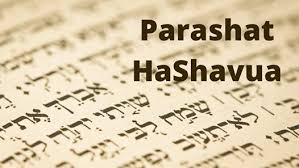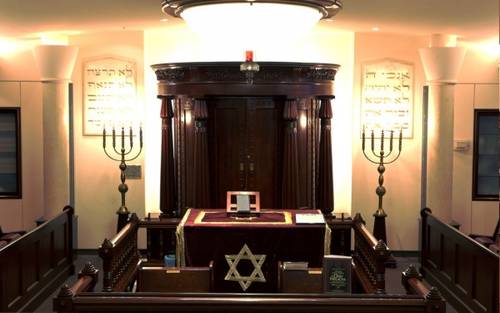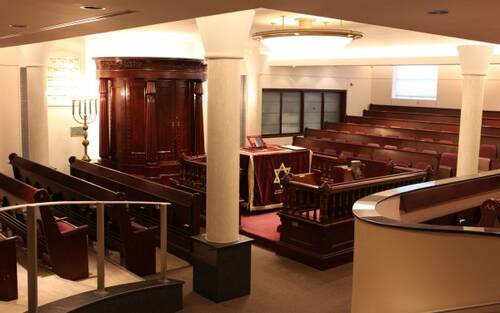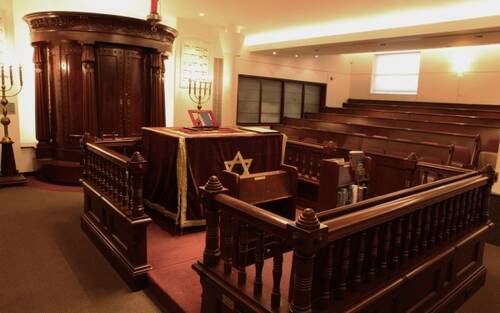Bonjour / Hello [nickname_else_first_name],
Table of contents
1) Perashat Hashavoua - Rabbi Eli Mansour
2) Halakhat Hashavoua (Halakhot related to day to day life) - Hazzan David Azerad
- Paraying in Minyan
3) Holy Jokes!
4) FOR KIDS!

1)PERASHAT HASHAVOUA
This Week's Parasha Insight with Rabbi Eli Mansour
Parashat Behaalotecha- Rectification is Always Possible
Parashat Behaalotecha begins with what appear as three unrelated topics, but which in truth share an important common theme.
The first topic is the command to Aharon regarding the daily kindling of the Menorah. Rashi explains that Aharon regretted having not participated in the special gifts and sacrifices brought by the leaders of the other tribes to celebrate the inauguration of he Mishkan. G-d told Moshe to reassure Aharon that although he did not bring these gifts and offerings, he has the greater privilege of kindling the Menorah.
The second subject discussed in this Parasha is the process of the Leviyim’s consecration. The firstborn, who were spared from the plague that G-d delivered in Egypt upon the Egyptian firstborns, were to serve as the attendants in the Mishkan, but they forfeited this privilege as a result of the sin of the golden calf. They were substituted by the Leviyim, who did not worship the golden calf along with the rest of the nation. The Leviyim were now formally consecrated, offering special sacrifices to atone on behalf of Beneh Yisrael for the sin of the golden calf.
The Torah then tells that when the time came for the offering of the Korban Pesach, there were some members of the nation who could not offer the sacrifice due to their status of impurity, as they had come in contact with a human corpse. They were given the opportunity to offer the Korban Pesach the next month, on the 14th of Iyar, a day known as "Pesach Sheni" ("The Second Pesach"), when those who could not offer the sacrifice on Pesach were able to make up the missed offering.
These three subjects share the common theme of rectification, receiving a second chance. Aharon regretted not having brought special gifts and sacrifices during the Mishkan’s inauguration like the other tribal leaders, and he was assured that his daily kindling of the Menorah was an even greater privilege. The nation committed a grievous sin by worshipping the golden calf, but even that failure was rectified, through the service of the Leviyim. Finally, those who were unable to bring the Korban Pesach were granted a second chance, and were invited to bring the sacrifice the next month.
These three sections prepare us for what we read later in the Parasha – the distressing stories about Beneh Yisrael’s complaints as they traveled through the wilderness. When we read these stories, we can become very discouraged, and feel as though our ancestors lost everything, that they had fallen to the point from which they could not recover. The first sections of this Parasha remind us that this isn’t true, that rectification is always possible. As Rav Nahman of Breslav (1772-1810) famously taught, "If you believe that you can ruin, then believe that you can repair."
I have sat many times with people who shared with me their angst and remorse over terrible mistakes that they made, and they doubted whether they should even bother continue observing the Misvot after what they’ve done. This is a familiar tool of the Yeser Ha’ra (evil inclination) – to thrust a person into depression as he thinks about his mistakes, so that he will decide to just give up. This is a very clever technique, as the person feels that giving up is the "righteous" thing to do, that he is supposed to beat himself up over his sins to the point where he falls into despair. We must remember that Hashem always invites us to rectify our mistakes, to repair the harm, to move forward and to advance. We should never feel it’s too late; no matter what mistakes we have made in the past, we are always given the opportunity to correct them and earn Hashem’s love and grace.

2) HALAKHAT HASHAVOUA
Halakhot selected and translated by Hazzan David Azerad
Laws of praying in a Minyan from Peninei Halacha
When ten Jews are engaged in Torah or prayer, the Shechinah dwells among them, as it says (Psalms 82:1), “God is present in a Godly congregation.” Although the Shechinah dwells even with one Jew who prays or learns individually, nevertheless, different levels exist. The highest level is when ten Jews are engaged in a matter of sanctity (davar shebikedushah), for then holiness is revealed to the world (see Berachot 6a). Based on this, the Chachamim established that all matters of sanctity be recited in a minyan. These include: Chazarat HaShatz (the repetition of the Amidah), Birkat Kohanim (the priestly blessing), Barchu, Kaddish, and the Torah reading (Megillah 23b).[1]
The Chachamim state that a prayer recited together with the congregation (b’tzibur) is accepted, as is written (Psalms 55:19), “He redeems me unharmed from the battle against me, for those with me are many.” Even when a congregation prays without full kavanah, HaKadosh Baruch Hu does not turn away from the prayers of the many (Berachot 8a). Although any prayer recited amongst ten Jews is more meaningful and accepted, the essence of communal prayer is ten Jews jointly praying the Shemoneh Esrei, also known as the Amidah.
Hence, praying in a minyan provides two benefits: first, in a minyan one may recite all those matters of sanctity that the Chachamim instituted; second, communal prayer is accepted on the merit of the congregation.
Since the Shechinah dwells in the midst of a minyan, every person should try to be one of the first ten people to arrive for prayer. If a person cannot be one of the first ten people to arrive for Shacharit, he should try to be one of the first for Minchah or Ma’ariv (Shulchan Aruch, 90:14; Ben Ish Chai, Miketz 1).
Bevirkat Shabbat Shalom Umevorach
David Azerad
3) HOLY JoKeS!!
Selection of funny snippets, loosely related to this weeks parashah or current events, to brighten your day


Click on the image to open the youtube video













